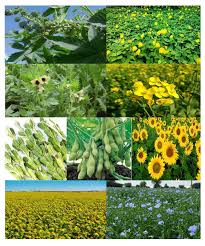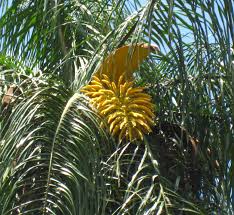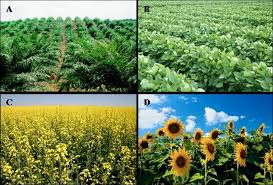Oil crops are those types of plants which are grown mainly for the oil they produce. For example: soybeans, canola, avocados, grapes, and almonds. Soybeans, peanuts, sunflowers, and canola are mainly used to produce edible oils.
Sunflowers are used to produce sunflower oils, peanuts are used to produce peanut oil (Ground nut oil) which is widely used to fry foods in many countries. Canola is used to produce Canola oil while Soybeans are used to produce Soya bean oil.
There are some major oils which are widely edible oil production and are also have other importance like being used as fuel oils and they include:
Coconut oil: This is a cooking oil which has medical and industrial uses and they are extracted from the kernel or the meat of the fruit of the coconut palm.
Corn oil: this is one of the principal oils sold as cooking oil and salad.
Read More: Modern Method of Oil Palm Cultivation
Cottonseed oil: Both domestically and industrially cotton seed oil are used as a salad and cooking oil.
Olive oil: They are used in cooking, in making cosmetics, making soaps, and it is also used as fuels in traditional lamps.
Palm oil: Palm Oil which is very popular in West African is used to produce palm oil (red oil) which are used in cooking, frying and also to make bio-fuel.
Peanut oil (Ground nut oil): This is used for salad dressing also used for frying.
Canola oil is one of the popular cooking oil.
Safflower oil is used in the paint industry and as cooking oil.
Soybean oil: Soya bean oil is produced from soya bean and the soya bean oil is produced as a byproduct of processing soy meal.
Related: Methods of Livestock Breeding in the Tropical Environment
Importance of Oil Crops
Vegetable oils have gained in importance during the past few decades resulting in the doubling of the world oil crop production in the last 25 years. Oil crops have been increasingly used as raw materials for food, livestock feed and non-food industrial applications.
Plant breeding has played an essential role in supporting these developments: Breeding for higher yield and oil content allowed for an increase in oil production per unit area, whereas breeding for better oil quality has improved both the human health value of vegetable oils as well as the suitability of particular oils in specific industrial applications.
Moreover, newly developed unique oil qualities are opening new opportunities in agricultural production and processing. Oil crop species have been developed in various botanical families from both the monocots and dicots.
Thus, oil crops are a highly diverse set of species from short season annuals to perennials with a life span of over 2000 years. Consequently, breeding methods used for oil crop improvement include clonal breeding, pure line breeding, improvement of open-pollinated populations as well as hybrid breeding.
In particular, the breeding procedures and techniques include almost every activity from simple mass selection and hybridization to specialized biotechnologies such as in vitro propagation or genetic engineering.
Related: 21 Amazing Importance of Water (H2O) to the Body
Oil crops for production of advanced biofuels

Oil crops are the base for biodiesel production. In Europe, rapeseed is the most common feedstock for biodiesel production. In the US, Argentina and Brazil, soybean oil is the most dominant biodiesel fuel feedstock. In Indonesia and Malaysia, palm oil is the main feedstock cultivated.
In 2008, 66 % of biodiesel in Europe came from rapeseed, 13 % from soybean and 12 % from palm oil (Junginger et al., 2014). Besides the most prominent oil crops (palm, soybean, rapeseed and sunflower), many other crops such as, canola, mustard, flax, jatropha, coconut, hemp, and pennycress are good resources of oil.
The use of corn oil is also gaining momentum in the United States, where large volumes of maize are used in ethanol production.
Companies such as Corn Oil One, Mazola corn oil, etc are developing improvements to crude corn oil to facilitate conversion into biodiesel. Innovative technologies for separation of corn oil are included on the process innovation page.
In the EU, concerns over iLUC and the Food vs. Fuel debate have led to proposals to limit biofuel production from food crops to 7 % (see proposed changes to the Renewable Energy Directive and Fuel Quality Directive).
This has accelerated interest in drought-resistant oil crops that can be cultivated on marginal lands and don’t compete with food crops.
However, there are doubts cast on the validity of the assumptions made and models used to underpin the iLUC debate. For example, in Germany in early 2015, UFOP published a brochure Opportunity or risk for the future!? presenting a more positive outlook on the benefits offered by Rapeseed and other oil crops.
Read Also: Reasons why you should invest in Oil Palm Business
Worldwide Production of selected Oil Crops 2014
| Oil Crops | Production (tonnes per year) |
| Oil palm | 52,821,076 |
| Soybean | 308,436,057 |
| Rapeseed | 70,954,407 |
| Palm kernels | 15,913,911 |
| Cottonseed | 46,657,005 |
| Groundnut with shell | 42,316,355 |
| Olive | 15,516,980 |
| Coconut | 61,440,691 |
| Maize | 1,021,616,584 |
| Sesame seed | 5,469,023 |
| Linseed | 2,564,535 |
| Safflower seed | 867,659 |
A = Aggregate, may include official, semi-official or estimated data
Source: FAOSTAT | © FAO Statistics Division 2016 | 02 August 2016
Examples of Oil crops
1) Oil seed rape (Brassica napus, B. rapa, B. juncea)
Globally, commercial supply is dominated by two species, Brassica napus L. and B. rapa L. Both species contain spring and winter forms that are distinguished by vernalization requirement. Seeds of these species contain 40 % or more oil and produce meals with 35 to 40 % protein.
Compared to soybeans, rapeseed can have more than twice the oil content but a lower protein level. World rapeseed production in 2015/16 is pegged at 68 million tonnes, a 4–5 percent drop relative to the preceding two years’ bumper harvests and is still ranked right after soybeans concerning the production of major oil crops (FAO, 2016).
2) Soybean (Glycine max)
Soy is a bushy, leguminous plant, native of South-East Asia that is grown for the beans, which are used in the food industry, for protein in cattle feed and for oil production.
The beans typically contain about 18 – 20% oil, 40% protein, 17% cellulose, minor contents are sugar, ash, fibre and other components.
Soybeans are the world’s largest oilseed crop, with a production of about 56 % of the world’s total oilseeds. The United States is the largest single producer of soybeans (FAO, 2016).
3) Sunflower (Helianthus annuus)
Sunflower grows in a variety of soil conditions but performs best in well-drained soils with high water-holding capacity. In drier regions it often needs at least supplemental irrigation for best yields.
However, sunflower is considered a drought tolerant oil crops and has a deeper root system than most crops. Sunflower seeds contain 45 – 55 % oil that is used for food, cosmetics or biofuel production. About 8 % of the world oil crop production were sunflower seeds according to the FAO (2014).
4) Jatropha (Various Jatropha species)
Jatropha curcas is a tropical plant that grows well on marginal land, is drought tolerant and has seeds with high oil content (~40%).
In common with other members of the family Euphorbiaceae, Jatropha contains toxic substances and therefore is unsuitable as a food/feed crop. Jatropha seemed a very promising candidate as a biofuel feedstock and an investment boom followed in the mid-2000s.
However, initial claims of high yields could not be verified on marginal lands; the early cultivars tested required lots of water, good soils and high fertiliser inputs to achieve high yields.
However research and investment in Jatropha continues. In 2014, Lufthansa signed a Memorandum of Understanding with JatroSolutions GmbH (a subsidiary of EnBW, the third-largest German energy company) to make jatropha production commercially viable.
In future, Lufthansa will help the start-up company to set up a raw materials supply chain to ensure the provision of biosynthetic fuel derived from the jatropha plant.
In 2014, Jatropower AG, Switzerland, acquired the assets of Qunivita BV. Jatropower offers a wide range of hybrid seeds and Jatropha cultivars.
Jatropower has a focus on high-yielding, non-toxic edible jatropha, which enables safer handling of the plant and allows for the use of the kernel meal (after oil extraction) as animal feed.
Its main research farms are situated in India, and it operates variety testing sites in Paraguay and Kenya. [Source: Jatropower].
NesteOil has also researched the use of Jatropha for biodiesel production. Galp Energia, Portugal is leading a research project on Jatropha for biofuels production in Mozambique.
Live-fence hedges of Jatropha with a double benefit may be a profitable option for small scale farmers in Africa. This was investigated in a project 2010 – 2011.
5) Camelina (Camelina Sativa)
Camelina sativa is an oil plant that grows well on marginal land, is cold-tolerant and has an oil-yield of 35-38%. Sustainable Oils (a partnership between Targeted Growth, Inc. and Green Earth Fuels, LLC) currently has 30 Camelina breeding trials in the US and Canada.
The company first provided Camelina-based biodiesel for a Japan Airlines test flight in January 2009. Biojet fuel derived from Camelina has been successfully used on many demonstration flights in the last five years.
The Eureka BIOFUEL-CAMELINA Project, coordinated by ISCO, Poland, studied the cultivation of Camelina sativa and cameline oil production, biofuel production and evaluation. The Camelina Association of Ukraine was established in 2014 for cultivation and commercial exploitation of Camelina sativa products in Ukraine.
6) Macaw palm – Acrocomia aculeata

The neo-tropical palm species Acrocomia aculeata naturally occurs in a wide range of tropical and subtropical environments. In contrast to the African oil palm, it tolerates low temperatures (> -5°C) without negative impacts on yields.
It grows between 30° north and south of the equator and is even found in areas with longer dry seasons up to six months such as the Chaco region of Paraguay and cerrado region of Brazil.
After five to six years it yields a harvest of 20 t/ha/a. Since this fruit is nontoxic, all parts of it can be used. All have their own market; however its potential in terms of food, feed and fuel is still underexploited.
Considering the yield of perennial plants, the Acrocomia palm (2 t/ha/a of Pulp oil and 1 t/ha/a of Kernel oil) can ranked in-between the African oil palm (Elaeis guineensis, 3 – 6 t/ha/a of Pulp oil and 1 t/ha/a of Kernel oil) and Jatropha (Jatropha curcas, 1 t/ha/a).
For the past decade, the University of Hohenheim in Germany and the Catholic University of Paraguay have worked together on the domestication of Acrocomia aculeata, which is endemic to the Americas.
There is substantial knowledge available on growth and yield performance to establish sustainable and rentable plantations. This palm is ideal for ‘peasant farmer’ cultivation, but is also well suied to sole cropping and agroforestry systems including silvo-pastoral systems.
Due to its perennial growth pattern and long-term ability to provide economic yields it offers a huge potential for carbon sequestration as well.
The fruits of Macaw palm, can be used to produce food, feed, energy/fuel and raw materials for the cosmetic and chemical industry. In Paraguay, currently ten oil mills are in operation using Acrocomia fruits for oil extraction, although almost all fruits are collected from wild growing palms with minor control of quality aspects.
Currently, further reseach to commecialise Acrocomia is taking place offering future potential, especially in Paraguay, Brazil, and Costa Rica where Acrocomia palm is planted and growing in various environments [Source: University of Hohenheim, 2014].
7) Dwarf saltwort / Dwarf glasswort (Salicornia bigelovii)
A salt mash halophyte that is found on both the east and west coast of the US and Mexico. The plant is of interest as a biofuel feedstock as it grows in desert environments, can be irrigated with seawater, and the seed contains around 30% oil content. It is being grown extensivley across the globe, for example in India.
In The United Arab Emirates, the Sustainable Bioenergy Research Consortium is developing an Integrated Seawater Energy and Agriculture System (ISEAS) to cultivate the halophyte Salicornia as a sustainable feedstock for biofuel production.
8) Cardoon (Cynara cardunculus)
The oil content of cardoon seeds (artichoke oil) is between 20–32 % (Pasqualino, 2006). The suitability as a feedstock for biodiesel production has been investigated in several studies (e.g. Pasqualino 2006, Torres et al. 2013).
Cynara cardunculus (Cardoon) has also been investigated as an energy crop for co-firing with lignite at the PPC Kardia Power Plant, Greece, as part of the FP6 DEBCO project.
9) Pennycress (Thlaspi arvense)
Has been investigated in the U.S. by USDA-ARS as a potential feedstock for biodiesel. Pennycress can be grown as a winter ground cover crop and harvested in the spring, providing soy farmers with additional income. Thlaspi arvense varieties are being commercially developed by companies such as Arvegenix.
10) Ethiopian mustard (Brassica carinata)
Brassica carinata oilseed has been developed as a biofuel feedstock (Resonance™) by Agrisoma Biosciences (Canada). It is suited to semi-arid areas and produces seed with 44% oil content.
In April 2012, Agrisoma announced that Resonance™ will be evaluated as a feedstock for Honeywell Green Jet Fuel™, and reported that the world’s first civilian flight powered solely by biofuel was flown from Ottawa, Canada.
11) Indian Beech (Millettia pinnata, Pongamia pinnata)
Millettia pinnata (Pongamia pinnata) is a leguminous tree species (15-25m) that grows widely Asia, including arid regions. It is pest resistant and produces seeds with 25–40% lipid content (nearly half oleic acid).
It also produces extensive root networks and can be used to prevent soil erosion (but also may cause problems as an invasive weed, if not properly managed).
12) Castor bean (Rizinus communis)
Castor oil is also being developed as a potential industrial-scale biofuel feedstock. “Castor bean is a non-edible, high oil-yielding crop (40%-50% seed oil content) with high tolerance for growth under harsh environmental conditions, such as low rainfall and heat” [Source: Evogene].
Related: The Effect of Heat Stress on Animal Productivity


I like this blog so much, saved to my bookmarks .
Thank you so much and we are glad that you find our article very helpful